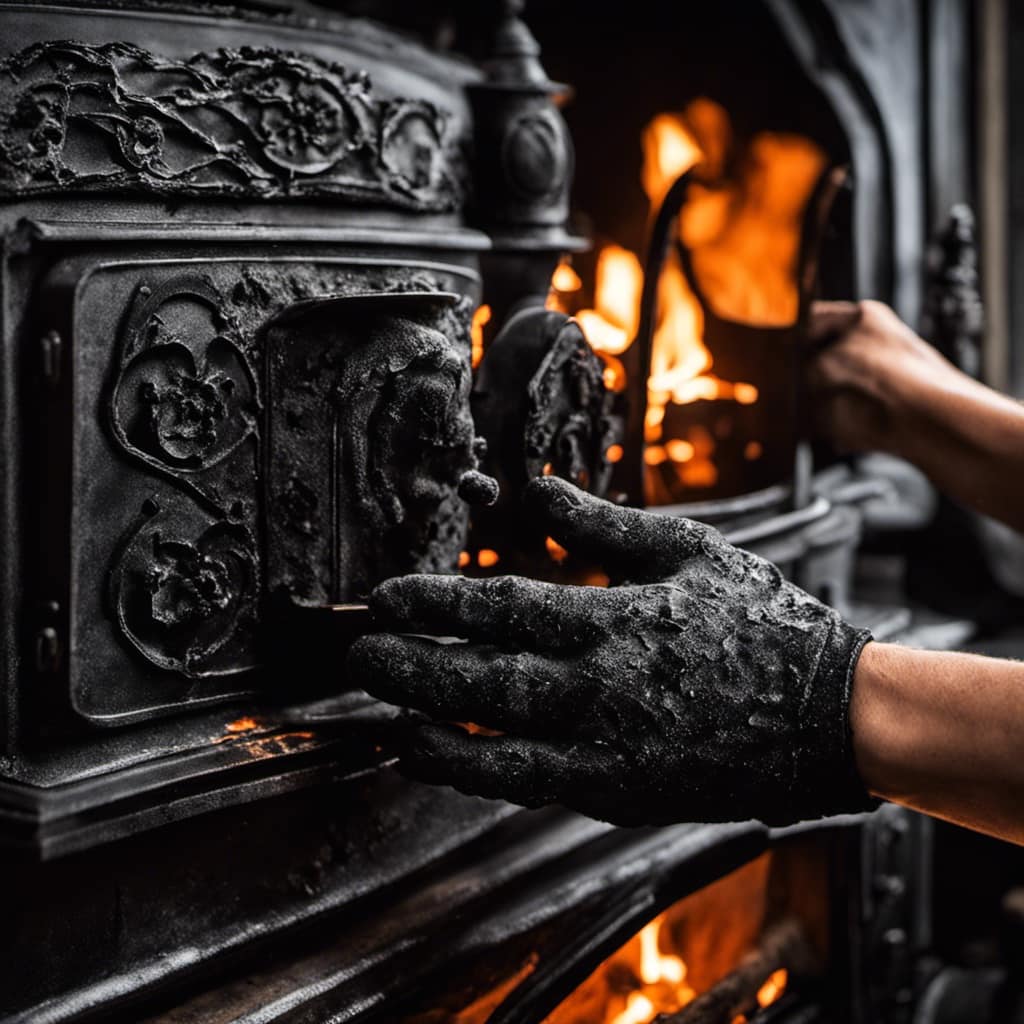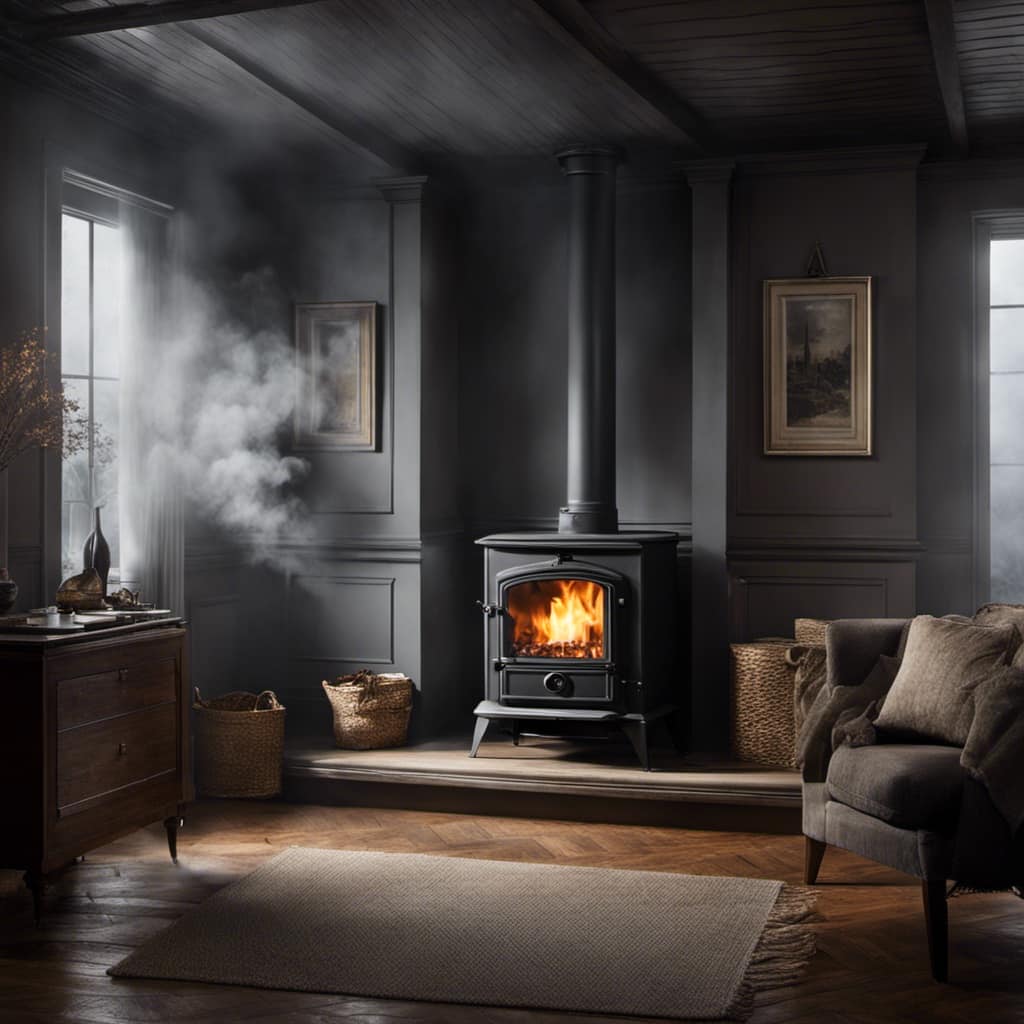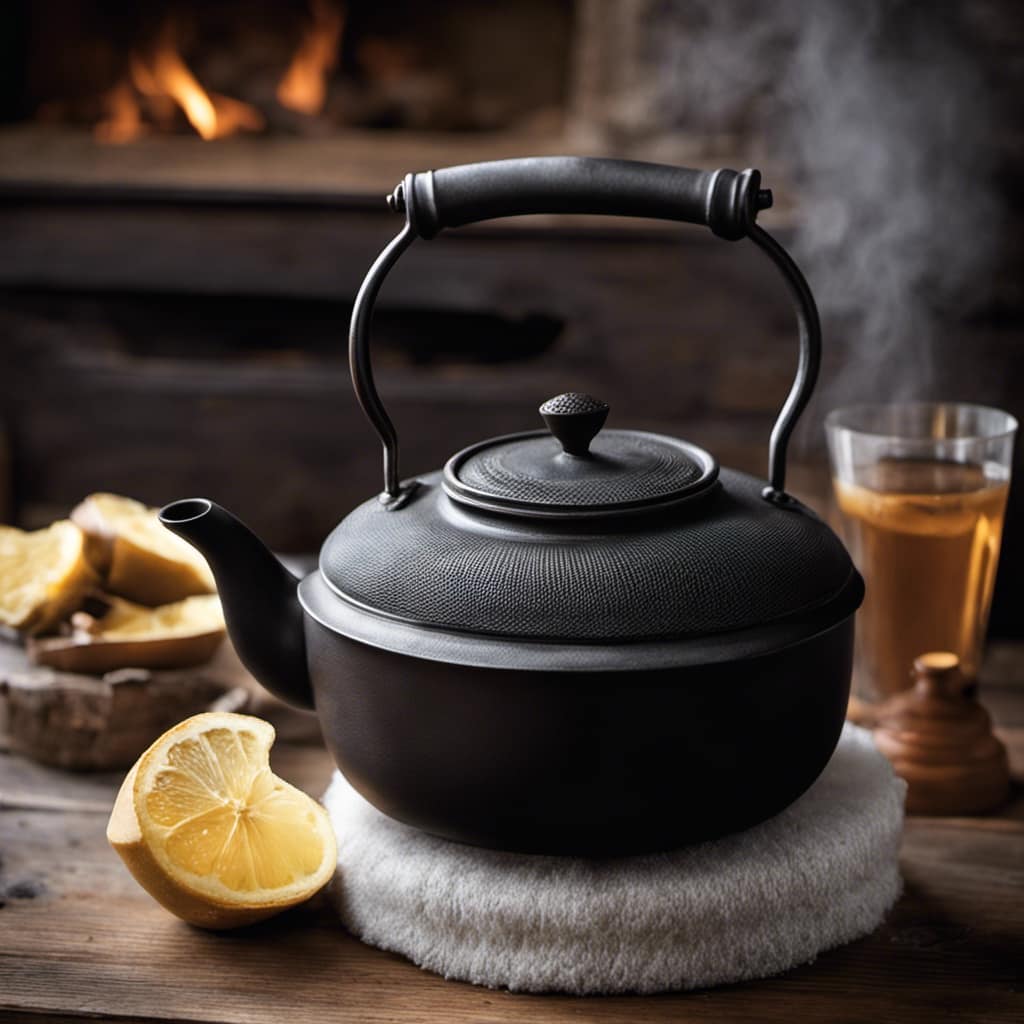Tired of dealing with a filthy wood stove? Curious about the best method for getting rid of all that ash? Your search ends here! In this article, I will walk you through the detailed steps for safely removing ash from your wood stove.
With the right tools and a little know-how, you’ll be able to maintain a clean and efficient stove all season long. Say goodbye to the mess and hello to a cozy, ash-free home.
Let’s get started!
Key Takeaways
- Regular ash removal ensures safer and more efficient operation of the wood stove.
- Removing ash prevents the build-up of creosote, a highly flammable substance.
- Ash removal allows for better airflow and improves the stove’s combustion process.
- Regular cleaning prevents clogging of the flue.
The Importance of Regular Ash Removal
I can’t stress enough the importance of removing ash from your wood stove on a regular basis. Keeping your wood stove clean is crucial for its maintenance and longevity.

Regular ash removal not only ensures a safer and more efficient operation of your stove but also provides several benefits.
By cleaning out the ash, you prevent the build-up of creosote, a highly flammable substance that can cause chimney fires. Additionally, removing ash allows for better airflow, improving the stove’s combustion process and heat output.
It also helps to prevent clogging of the flue and reduces the risk of damage to the stove’s components.
Therefore, make it a habit to clean out the ash from your wood stove regularly to maintain its performance and ensure a safe and enjoyable heating experience.

Gathering the Necessary Tools
Before starting the process, make sure you have all the necessary tools, such as a metal ash scoop and a heat-resistant bucket, to safely gather and dispose of the ash from your wood stove. Cleaning the ash from your wood stove is an important task to maintain its efficiency and prevent ash buildup.
Here are some key points to consider when choosing the right cleaning products and preventing ash buildup:
- Use a vacuum specifically designed for ash removal to ensure thorough cleaning without dispersing ash particles into the air.
- Avoid using water or wet cleaning methods as they can create a messy paste and damage the stove.
- Opt for natural cleaning products that are safe for the environment and won’t leave behind harmful residues.
- Regularly remove ash from the stove to prevent it from reaching dangerous levels and interfering with airflow.
- Conduct a deep clean at least once a year to remove any stubborn residue and keep your wood stove in optimal condition.
Step-by-Step Guide to Safely Removing Ash
During the cleaning process, it’s important to carefully remove ash from the wood stove step-by-step, using a metal ash scoop and depositing it into a heat-resistant bucket. Safety precautions should always be taken to prevent any accidents or injuries. Before starting, ensure that the stove is completely cool to the touch. Wear protective gloves and a dust mask to shield yourself from ash particles.
Begin by opening the stove door and using the ash scoop to gently collect the ash from the bottom of the stove. Be thorough in your cleaning, making sure to remove all the ash. Once the ash has been collected, it’s crucial to properly dispose of it.

This leads us to the next section where we’ll discuss the proper disposal of ash.
Proper Disposal of Ash
Additionally, when disposing of ash, it’s crucial to properly seal the container and store it in a designated area away from flammable materials. Safe handling and proper ash disposal methods are essential to prevent accidents and maintain a clean and safe environment.
Here are some important tips to follow:
- Use a metal container with a tight-fitting lid to store the ash.
- Allow the ash to cool completely before transferring it to the container.
- Avoid using plastic bags or containers as they can melt or catch fire.
- Keep the container in a well-ventilated area to minimize the risk of any remaining embers igniting.
- Dispose of the ash in accordance with local regulations and guidelines.
By following these guidelines, you can ensure the safe disposal of ash and reduce the risk of accidental fires.

Now, let’s move on to some tips for maintaining a clean wood stove.
Tips for Maintaining a Clean Wood Stove
I find regularly sweeping out the ashes and wiping down the interior of my wood stove keeps it clean and functioning efficiently. Maintaining efficiency is essential to ensure the proper operation of a wood stove and to prevent fire hazards.
Ash buildup can restrict airflow, reducing the stove’s efficiency and increasing the risk of a chimney fire. To clean the stove, I start by wearing protective gloves and using a metal scoop to carefully remove the ashes. It’s important to wait until the ashes have completely cooled down before disposal.
Once the ashes are removed, I use a soft brush or vacuum to clean the interior surfaces, removing any soot or debris. Regular maintenance like this helps to prevent the buildup of flammable materials and keeps the stove working safely and efficiently.

Can the Product Used to Clean Wood Stove Glass also be Used to Clean Ash from the Wood Stove?
Yes, a cleaning wood stove glass product can also be used to clean ash from the wood stove. This multipurpose cleaner is specifically designed to tackle tough stains and buildup on the glass surface, making it effective for removing ash residue as well.
Frequently Asked Questions
Can I Use Water to Clean Out the Ash From My Wood Stove?
Using water to clean ash from a wood stove can be effective, but it has pros and cons. Water can help with removing loose ash, but it can also create a messy slurry. It’s important to be cautious and avoid water damage.
How Often Should I Clean Out the Ash From My Wood Stove?
I clean out the ash from my wood stove every week to prevent buildup. It’s important to do so regularly to maintain optimal performance. It is safe to dispose of wood stove ash in the garbage.
Can I Use a Regular Vacuum Cleaner to Remove the Ash From My Wood Stove?
Yes, you can use a regular vacuum cleaner to remove ash from your wood stove. However, it is important to use a vacuum specifically designed for ash to prevent damage and ensure safety. There are also alternative cleaning methods available.
Is It Necessary to Wear Protective Gear While Cleaning Out the Ash From My Wood Stove?
It is necessary to wear protective gear when cleaning out the ash from a wood stove. However, there are alternative cleaning methods available that may not require the same level of protection.

Can I Use the Ash From My Wood Stove as Fertilizer in My Garden?
Using wood ash as fertilizer in your garden is a great idea! It’s like giving your plants a nutrient-rich spa treatment. Just make sure to follow wood stove safety guidelines and only use ash from untreated wood.
Conclusion
In conclusion, cleaning the ash from your wood stove isn’t just a simple task, but a crucial one for maintaining its efficiency and safety. By following the step-by-step guide and gathering the necessary tools, you can ensure a thorough and proper ash removal process.
Remember to dispose of the ash properly and maintain regular cleaning to keep your wood stove in top shape. Trust me, a clean wood stove will make all the difference in your heating experience!
Growing up surrounded by the vast beauty of nature, Sierra was always drawn to the call of the wild. While others sought the comfort of the familiar, she ventured out, embracing the unpredictable and finding stories in the heartbeat of nature.
At the epicenter of every remarkable venture lies a dynamic team—a fusion of diverse talents, visions, and passions. The essence of Best Small Wood Stoves is crafted and refined by such a trio: Sierra, Logan, and Terra. Their collective expertise has transformed the platform into a leading authority on small wood stoves, radiating warmth and knowledge in equal measure.











